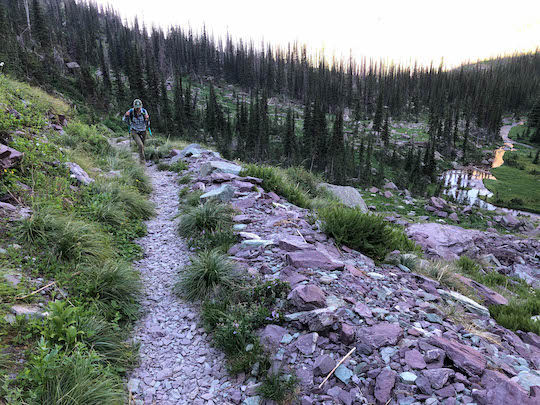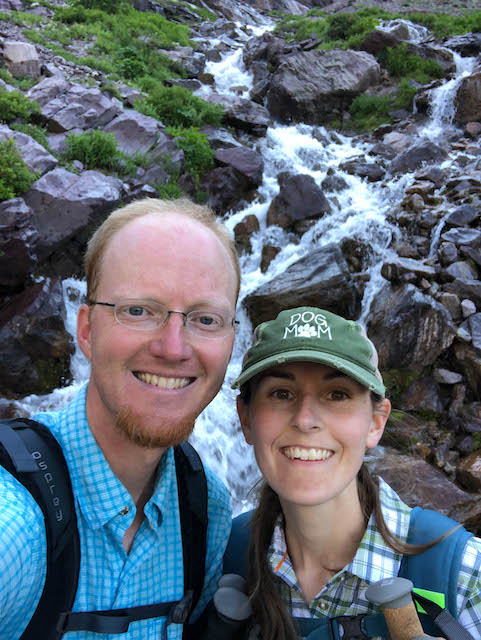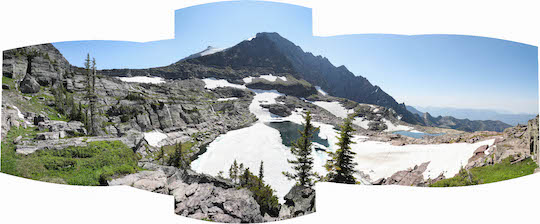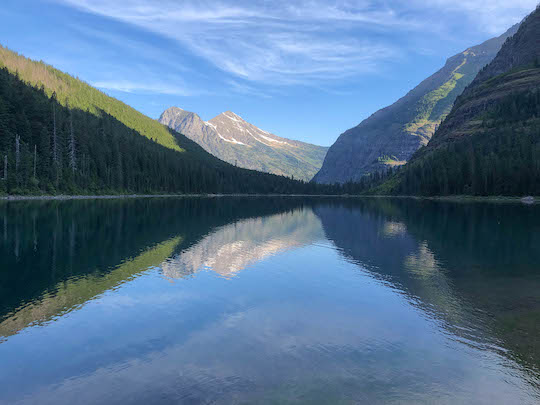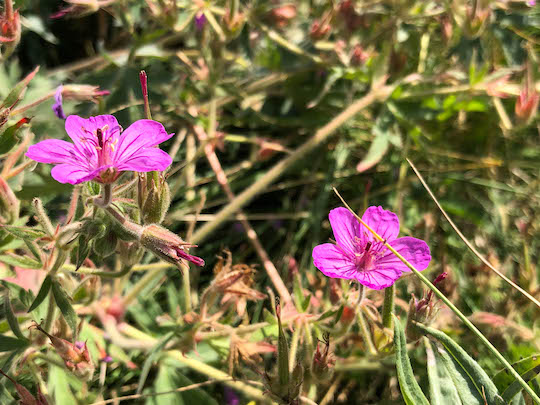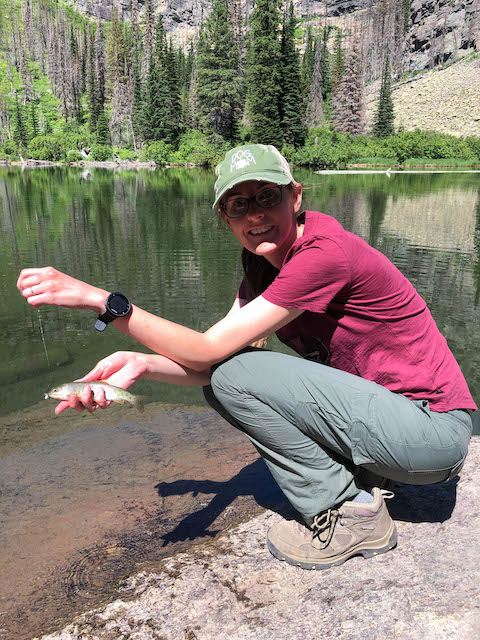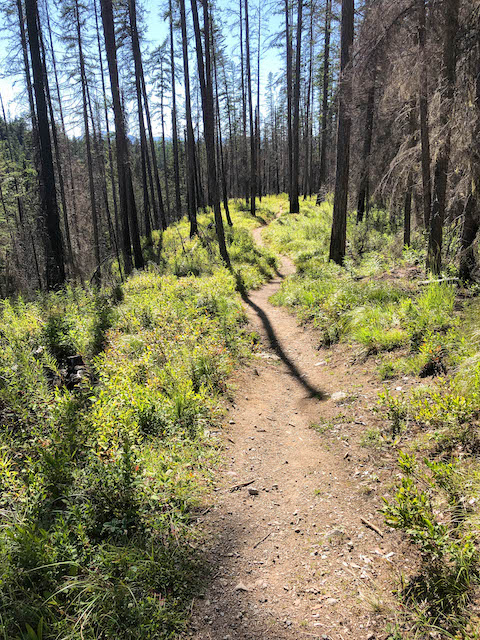Featured Photo: Morning Reflections

Monday, January 25, 2021
Glacier Day Five: Hiking to Sperry Glacier Part One
Sunday, January 24, 2021
All It Takes Is One
Most anglers I know like to catch fish when they go fishing. There are more than a few I know that like to catch a lot of fish or even better, a lot of big fish. Then there are the anglers that are content with just a fish. On hard days of fishing, one fish can make or break a trip. As a guide, you generally hope to knock a fish out early because it helps everyone loosen up. When anglers get uptight, they don't fish as well. In fact, I've had at least a few tough days on the water where I knew it was just time to give it up and quit. Not guiding, rather just fishing for myself that is.
I've had many great days in terms of numbers. Occasionally I've even been blessed to enjoy days with good numbers of big fish. Most days, however, tend to feature either one or the other. Head hunting is something that I rather enjoy, but it also comes with the general understanding that there probably won't be a lot of fish caught. Some of the best days are the ones that kind of sneak up on you, however.
Cinch or Grinch?
Last week, I was fishing with my friend and fellow guide, Travis Williams. We had already been on the water a while and things were generally slow. Travis had managed a handful of tugs early on a streamer. We had also seen an indicator dive a handful of times, but we're never sure if it was on fish or the bottom. By mid afternoon, things were starting to look like a typical Grinch day. If you've fished the Clinch very much, you know what I'm talking about.
The wind had picked up even though the forecast had promised calm winds. One given on the Clinch is wind. In fact, my general rule of thumb is to take whatever wind forecast the National Weather Service Forecast Office in Morristown gives for the vicinity of the Clinch and double it. That will get you at least in the rough ball park of the expected winds. Still, I haven't figured out a rule for a calm wind forecast. Based on our experience Friday, you can probably still count on at least ten mile per hour breezes.
With the wind blowing, I was no longer able to both row and fish. We had spotted a couple of fish rising over a shoal so I dropped the anchor. With the boat stabilized in the falling water, I moved to the back of the boat and we both fished for a while. In fact, I even caught a fish. This typical Clinch rainbow ate a small #22 midge pattern I had been drowning under a slightly larger midge with a New Zealand Indicator holding everything up. The fish pulled hard and generally gave a full account of itself, and I was content. All it takes is one, right? On a Grinch day that is definitely the case.
Glad to not be skunked, I was about to pull the anchor to row Travis on down the river in search of a fish for him. Right before I pulled it up, Travis said, "There's another rise!" This fish was just barely within casting range. Travis was fishing a new 10' 5 weight Orvis Recon and that thing could really lay it out there. With him in the front of the boat raining casts down on the working trout, I moved back to the rear brace again and threw my flies well upstream of where he was fishing as an afterthought. On the second cast, the indicator dove but I was late to the party. With no resistance, I slung the flies back thinking there was no way the fish would eat again.
A Big Trophy Clinch River Rainbow Trout Encounter
I guess we'll never know if it was the same fish, a different fish, or if the first plunge of the indicator was even a trout. Either way, when I set this time, there was actually a fish on the end of the line. As I quickly gained line, I expected the usual Clinch slot fish in the 16" range. Not too far out from the boat, the fish got a touch heavier. By the time it got really close and finally realized it was actually hooked, I still hadn't gotten a good look. The fish was staying too deep. That should have been a clue.
The increasingly heavy trout made a u-turn and headed back out to sea, er, the river bank. Mere feet from the bank in the same vicinity as the trout Travis had been hoping to catch, the fish finally came up and broke water. As it rolled, I suddenly realized I was dealing with something a lot larger than my previous guess. Things got pretty serious at that point. Travis rolled up his line to get out of the way and also grabbed the net.
Somewhere in all the commotion, the fish rubbed me around either a rock or a stick or log. Not much later, it did the same thing again. Each time, I was certain the fish would be gone. You see, I was expecting most of my fish on the smaller midge. That fly was tethered to the other fly via a small section of 6x fluorocarbon. Great for fooling fish, mind you, but not so good for landing them if they get smart. However, once the fish finally came to hand, we discovered it was actually on the larger midge on much more secure 5x fluorocarbon.
The fish absolutely did not want anything to do with the boat, but eventually I got the head up and Travis made quick work of him with the big boat net. We took a couple of pictures. This might have been my largest Clinch River rainbow trout. Measuring in at 22", the big kype jawed male was a stunner and a true Clinch River trophy. Eventually, with luck, I'll probably find one bigger yet. But for now, I was happy to have landed such a special fish and was done fishing for the day. Really, all it takes is one, but it helps when that one is such a special fish.
 |
| Pictures courtesy of Travis Williams, ©2021 |
A Word On Catch and Release on the Clinch River
A big reason this fish was so special is that the protected length range in effect on this river does wonders at protecting fish in the 14-20" range. However, as soon as fish eclipse the 20" mark, they often leave the river on a stringer. While we see lots of fish in the 16-19" range as a result, we don't see fish over 20" nearly as often. Unfortunately, many people don't realize that this is a limited resource and thus choose to harvest these beautiful big fish. While not illegal, it is incredibly short sighted.
All of our tailwaters here in Tennessee could greatly benefit from more anglers releasing their catch. If you enjoy catching lots of fish and especially lots of big fish, consider that a trophy like that has been in the river for a minimum of 5 or 6 years. Every fish you harvest is one more fish that will never grow to be a monster. I've seen people wishing that our rivers produced 15 or 20 pound brown trout. They can and would, but only if people keep releasing everything they catch under that size. These big trout are a product of several years of growing in our rivers, but they must be released to swim and grow another day.
Please, if you enjoy fishing our rivers and streams here in Tennessee for trout, consider practicing strict catch and release. It is not worth killing a big beautiful wild or holdover trout. Yes, it is your right, but better fishing starts with anglers making better choices. With increasing numbers of anglers on our rivers creating pressure like never before, it will be up to us anglers to self regulate and do what is best for the river and the fish.
Recent Articles From the Trout Zone You Might Enjoy
Sunday, January 17, 2021
Winter Is For Fly Tying
During the cold months, when I'm not out fishing, I'm usually getting caught up on my tying for the year. That doesn't mean I won't tie throughout the season as well. Normally I have to tie at least weekly and sometimes more. If I'm fortunate, however, I can get far enough ahead now that I won't have to tie large quantities until next winter. That opens up more time for fishing and of course doing other important things.
I like to pursue my winter fly tying in an orderly fashion. Typically, I focus on the flies that I go through the most in a normal season. That means lots of midges for the tailwaters and the usual nymphs, dry flies, and terrestrials for the mountains. As a guide, I tie the vast majority of the flies I guide with. There are some exceptions though. While I really enjoy tying stimulator and parachute style flies, I will often buy a good supply of those in bulk because of how many I go through in a season. Nymphs and midges, on the other hand, are flies that I can produce quickly in bulk and make sense to tie my own. This is especially true because I tie some patterns that you cannot purchase commercially.
And that is at the root of my fly tying. I like to experiment. Tweaking existing patterns and also coming up with my own flies is part of the excitement of the sport of fly fishing. It is said that there is nothing new under the sun. Thus, most of my supposed inventions are ones that someone else is tying somewhere else. In fact, most of my inventions were motivated by flies that I've already seen or been told about. However, when there are more and more anglers out on the water than ever before, sometimes the difference between a slow day and a good day is just a subtle variation on a standard pattern. The fish see the same "shop flies" over and over again every day on some rivers. Sometimes, those shop flies work great, but you have to think outside the proverbial box.
This last year in the Smokies, I had a late season epiphany that really changed the success we had one day on a brook trout stream. The common wisdom is to fish yellow well into the fall. That is because of the availability of a vast array of yellow bugs in the warm months, perhaps the most important of which are the little yellow stoneflies found so plentifully on our southern Appalachian streams. In other words, the conventional wisdom is there for a reason and usually yellow works. However, when you are on a fairly pressured stream, never mind that you're fishing for brook trout, there comes a point in the season when the fish start to get finicky. That's a good thing and just means that the vast majority of anglers are releasing their catch which is as it should be with these native jewels.
Anyway, back to my story, there we were on this brook trout stream and the fish are only half-heartedly inspecting our standard yellow dry flies. Going smaller in size got a bit more interest, but it was clear that the fish were onto the game at this late point in the season. So what did we do? Small, dark, and subtle. I didn't notice any dark bugs on the water, although in the Smokies anything is possible at almost any time of the year. What I did notice, though, was that the brook trout were no longer shy. Even with brook trout, showing them something they aren't used to seeing can be the ticket.
On the tailwaters, that means carrying a large variety of color schemes on my midges. In particular, I carry a wide variety of colors with my Zebra Midges. It is no coincidence that my old article on fishing the Zebra Midge is one of the all time favorites on this blog. This is one of the most fish catching flies that I know of. I mostly use it on the tailwaters, but it also catches fish in the Smokies. There are so many possible combinations of bead color, wire color, and thread color, that I couldn't begin to list them all here. I will say that some of my favorites include black and silver, black and copper, olive and copper, and chocolate and copper. Most of my most successful midge patterns are darker, but sometimes lighter colors are the ticket.
Recently, I decided to share a quick video of tying the Zebra Midge over on YouTube. If you haven't already, check out my channel there. My goal is to share a lot more content via video in addition to the usual blog posts here. While you're there, make sure and subscribe to the Trout Zone Anglers channel. There is another midge pattern that I have shared there that I probably fish even more than the Zebra Midge these days. It has accounted for more fish over the last few years than any other fly and also plenty of big fish. For those of you who are experienced fly tiers, these videos probably won't provide much new info, but I'm mostly trying to help out those who are just getting into fly tying.
The recent explosion in popularity of fly fishing is bringing more and more people into the sport. Not everyone will decide to also take up fly tying, but the satisfaction it brings is well worth considering. Because our good friends at Little River Outfitters are not able to do tying classes right now because of COVID, I'm going to try and share tying videos more often over the next couple of months. If you have a specific pattern you would like to see (or other content), please let me know in the comments below OR send me an email.
Back to my fly tying, I'll work on midges and streamers for now. I have several tailwater guide trips lined up and those are the most likely to be needed over the next couple of months. As we get closer to spring in the mountains, I'll be tying quill gordon and blue quill imitations in anticipation of the first hatches of spring. I also need to replenish my little black caddis imitations. This is an overlooked hatch that can provide surprisingly good fishing.
Before late spring, I also need to replenish my terrestrial box. Mostly that means making sure I have plenty of green weenies and barbie bugs along with some beetles and ants. What I really need to do is get out all my fly boxes and start working on refilling them in an orderly fashion. This guarantees that I won't forget something important. One of the worst feelings is getting out on the stream only to discover you don't have the right pattern.
If you carry a tying kit with you, then you could quickly spin up a couple. That doesn't work very well when you're guiding unfortunately. To be fair, who carries a tying kit with them on regular fishing trips? I take one with me on big trips. I have many good memories of sitting at a picnic table in the evening in Yellowstone or Colorado and whipping up some bugs for the next day. Nowadays, I try to prevent this from being necessary by planning ahead though. If you haven't gotten into fly tying yet, consider giving it a try so you can be prepared as well.
Friday, January 15, 2021
When the Fish Are Where They Should Be
A big part of guiding is knowing where to find fish. Of course, it also helps to know what those fish will eat once you find them. However, if you can't find fish, then it won't do you any good to have the right flies. Some days are easier than others, of course. On those days, the fish are where they should be. You know what I mean. Those obvious spots that hold fish more often than not are popular with lots of anglers for a good reason. Sometimes, those spots aren't quite as obvious. Nevertheless, if you know the water well, the fish are still where they should be.
Yesterday, I was able to get out and fish a river that I haven't been on as much as I would like lately. This lack of fishing is mostly because I've been busy with non fishing things. This is the time of year that I'm able to catch up on things that get neglected through a long and busy guiding season after all. Still, it was good to get out and the weather was about as pleasant as you can ask for this time of year.
My buddy John came along to fish and help rowing a little. We started while the generators were still running. John wanted to try his streamer setup with some newly tied streamers. Those proved enticing to some skipjack but at this point, the trout eluded us. As soon as the water cut off, we started slowly drifting down the river with what we thought were the right flies fished in the right places. And we drifted, and drifted, and so on and so forth. Fish were occasionally rising so we knew there were some around. We weren't sure how many, but some fish is better than no fish. Amazingly, we were much farther down than we had wanted to be without a bite and it was time to change. I suggested a possible fly I was considering, and John said he was thinking the same thing.
I anchored for a minute while he changed his rig and then started drifting again. Not too far down the river, we were coming into a run that has historically held plenty of fish but has been slow the last few years. I positioned the boat and suggested he switch to the right side of the boat. A short drift later, his indicator went down and we were into our first trout of the day. When he almost immediately got another bite in the same spot, I started thinking that I should probably change flies as well.
By the time we got to the next big run, I had switched up flies as well. With the boat in the perfect spot, I decided to anchor for a bit so we could both fish. The wind was blowing strong so we had to work a little at casting and mending. Once the drift was started, we could extend it by throwing more line into the drift with the rod tip. Keeping just enough slack is tricky in this situation. If you get too much, then setting the hook is nearly impossible. Not enough and you'll end up with immediate drag.
Finally, after several solid drifts, my indicator shot under and when I set the hook, I knew it wasn't a little stocker rainbow. After a strong fight, a healthy brown trout can to hand in the 14 inch range. I took a couple of closeups because the fish had incredible blue spotting behind the eye. After a few more drifts without another bite, I pulled the anchor and we started down the river. A few bites came as we moved through the tailout of the pool, and then we moved on down to the next spot.
The next little run was where things started to look predictable. I again maneuvered the boat into position and suggested John try a spot to our left. After a short drift, just when I was thinking that maybe there weren't fish there, the indicator shot down. We quickly netted the rainbow and on the very next cast, he had another bite. The fish were where they should be.
That pattern then continued on down the river. In fact, several of his fish came after I said something like, "You should have a hit any second." Those are the sorts of things guides love. This wasn't a paid trip, of course, but it always gives you confidence. Clients always think you're a magician when you predict bites a second before it happens. There really is no magic here, though. The fish are simply where they should be.
To learn where the fish should be, it is necessary that you spend a ridiculous amount of time on the water. This knowledge is not something that happens overnight. Often, these things can change year by year. Yesterday, I was noticing how much the river has changed over the last few months and also how it is similar to the usual river we all know and enjoy. Features change, fish move, but they also are where you would expect.
The best fish of the day was near the end of a stretch that had produced a few fish already. We were nearing the end of one of the better pools. I suggested to John to get a little closer to the far bank. He dropped his fly into position. The mend set up the right drift and soon the indicator was diving. When he set the hook, the fish seemed a little more solid. It came mostly right to the boat though. When he lifted its head, the fish saw the boat and went ballistic. We came close to losing this beauty in the resulting fight, but somehow everything held. We had to pull over for a quick picture of this fish before heading on down the river towards the takeout ramp.
Tuesday, January 12, 2021
Glacier Day Four: Hiking to Avalanche Lake and Going Back to Polebridge
This was our last short day before we attempted a big hike. When I say short, some people might disagree as we put about 7 miles on our boots. We were starting to get in a good hiking rhythm, though, and were about ready for much bigger things. To obtain parking, we did our usual early start and caught yet another amazing sunrise. Probably we should have been up another hour earlier and tried to catch the sunrise from Logan Pass, but getting up at 5:00 am seemed reasonably early to both of us but 4:00 am not so much.
Parking and Hiking to Avalanche Lake
Avalanche Lake in Glacier National Park
Back to Polebridge and Visiting Bowman Lake
Friday, January 08, 2021
Glacier Day Three: Hiking to Hidden Lake, Pole Bridge, and Fly Fishing the North Fork Flathead River
One advantage of the early starts we were getting every day was the chance to enjoy sunrise every morning. This is something I always enjoy as a fishing guide since I’m often on the road by five or six each morning. For this day of hiking, we hit the road by about 5:30 am and were none too early. We got one of the last parking spots when we arrived at the Logan Pass Visitor Center around 6:30 am.
Our plan was to wander down to Hidden Lake and maybe even enjoy some fishing. This lake is supposed to contain Yellowstone cutthroat trout that are relatively easy to catch. The Tenkara rod was packed accordingly along with snacks, bear spray, water, and of course our cameras. We had our quick breakfast of fruit, granola, yogurt, and nuts and noticed quite a few other people doing the same thing. Soon we were done and ready to start moving.
Hiking to Hidden Lake in Glacier National Park
As we walked across the parking lot and up the stairs to find the beginning of the trail behind the visitor center, we were excited for what the day might hold. This excitement was quickly tempered when we found a sign at the beginning of the trail announcing a closure from the overlook onward. Apparently, the trail was closed because the cutthroat were spawning, and the bears were concentrated in area of the outlet stream looking fish to eat. Another bummer, but also another reason we need to return to Glacier National Park for another try. Still, we were already there and ready to walk. Up to the overlook we went.This was the most crowded trail we hiked in Glacier with only the Avalanche Lake Trail being anywhere close. The reason for these trails’ popularity becomes obvious when you realize that they are two of the shortest trails and also two of the more scenic. Soon, we would be looking for longer hikes that would offer more solitude. At this moment, though, we were just happy to be tourists and see the sights.
The trail is a boardwalk for quite a distance. This helps protect the fragile alpine environment (please stay on the trail!!!) and also inadvertently provided some type of structure for marmots to live under. We found one of my favorite creatures of the Rockies early in our hike, and I had to stop for some pictures before moving on.
The trail heads slowly uphill towards the southeast flank of Clements Mountain. Wildflowers were abundant here. While I was tempted to pull out my good camera, I kept using my cellphone and snapped a few quick shots of the glacier lilies which reminded me a lot of the trout lilies back home in Tennessee. In hindsight, I wish I had spent more time photographing them as we wouldn't find many more during our time in Glacier National Park. I didn't realize it at the time, but we were already late in the season to be finding them. Most of the specimens we saw were already starting to fade and wilt.
Mountain Goats Near Hidden Lake Overlook
Soon enough, the mountain goats wandered off and we turned back to the scene before us. Hidden Lake is spectacularly beautiful. I hate that we didn’t get to hike on down to the lake, but we enjoyed the views we had and the extra time it saved allowed us to enjoy some other portions of the park.
Finishing the Hidden Lake Overlook Hike
Fly Fishing the North Fork Flathead River near Polebridge, Montana
The warm afternoon breeze had me thinking hoppers. I quickly rigged a fly rod with a big foam bug and was soon wading in my sandals. Surprisingly, the fish would at least check out my offering but were being a little shy. I’m guessing they got at least some pressure based on both the fishermen’s trail from where we parked and also the constant parade of boats going by. At least a few of the passing boats contained anglers.
Finally, after switching flies a few times, I settled on a small yellow stimulator and was soon catching plenty of fish. They weren’t really picky exactly, but they did want something a little more natural. Despite my hopes, there wasn’t a massive grasshopper hatch in progress and the fish were looking for aquatic insects hatching. The bright sunny day had some caddis popping along with a few smaller stoneflies. Interestingly, they weren't as interested in nymphs or pupa patterns as they were in dry flies. Cutthroat trout just really like dry flies!
The fish here are not big, or at least I didn’t find any large ones. They were larger than the small fish at Snyder Lake the day before though. They were also reasonably willing to eat a fly, at least once the correct fly was tied on. I caught a few and offered the rod to my wife, but she declined. I got the idea that she might prefer to continue our search for animals, so before long we were back on the road. It was getting later in the day now, and we hoped to find some wildlife moving about.
Back to Camp For the Night
Apparently it was not meant to be. We made the drive back down to the Glacier Campground via the Camas Road through Glacier National Park. There were some nice meadows but no wildlife feeding in them. The hot weather probably had most of the wildlife either in the woods or at higher elevations. We made it back to camp in time for a leisurely evening. We had another very early start ahead of us to find parking at one of the most popular trailheads in Glacier National Park. Back in camp, we found one last bit of wildlife for the day...Wednesday, January 06, 2021
Winter Light Moods
Last week, I was driving home from a quick exploratory trip to the Caney Fork. The day had been perfect with relatively warm temperatures for this time of year. We had even found a few fish which means the river isn't completely barren. Anyway, I got fed up with the traffic on the interstate and decided to take the scenic route home to bypass any potential slowdowns on the mountain at Monterey. The alternative route I chose was highway 70N which more or less parallels the interstate.
The magic happened as I crested the top of the Cumberland Plateau. The late day sun broke through the clouds to illuminate the trees ahead of me. The rich warm glow was too much for my cellphone although I snapped a quick picture to share with my wife. This time of year, with a low sun angle, we got lots of light magic. With an extended golden hour, the sunsets last longer and are often more dramatic than at any other time of year. However, that isn't the only benefit of low sun angles.
Yesterday, while we are shooting some other unrelated pictures, I happened to glance at the sky as we were wrapping things up. The low sun angle at midday resulted in bright rays slanting through the clouds. Most of the year, there is only a narrow window early and late in the day when this can happen. In the winter, it is possible pretty much all day making it more likely to encounter.
My camera was already in hand. Almost without thinking, I snapped a few quick shots. Once I got the pictures on my computer, I realized that some editing might be in order. In the end, I like the black and white look as it accentuates the play of light across the heavens and minimizes other distractions. The only thing I can't decide between is whether I like a lighter or darker foreground. These are two edited versions of the same original. Which do you like best?
Monday, January 04, 2021
New Year Trip Planning
Every winter, in between fishing trips, I begin planning my fishing for the next twelve months. I also tie flies, clean gear, and make sure everything is ready for another season. This is the slow time, but also the time to start planning for the next adventure. Excitement and anticipation builds as we head towards the first spring hatches in February or early March, and before I know it, we'll be right in the middle of summer with plenty of fishing.
This year might be a little different for me. For those of you who subscribe to the newsletter, you probably already know where this is going. If not, then here is a picture that sums it up perfectly.
We are super excited for Baby Knapp, due this May. Of course, that changes the situation for fishing trips. I doubt we'll be pursuing any major adventures this year. Cross country road trips with a newborn sound like a terrible headache. If I'm lucky, I might sneak out a few times between now and when the little one makes the grand entry. After May, I doubt I'll be out on the water much outside of guiding. I'll probably aim to start getting out occasionally again once things start to cool off. Fall is always my favorite time to get out anyway.
Since I'm not planning any fishing trips for this year, I will be hoping to inspire YOU to get out and travel this year by sharing stories from years past. The current series on Glacier National Park still has a lot more articles. I really haven't even begun to share everything from our Yellowstone trip in 2018 and haven't touched Colorado 2019 either. There are lots of good stories I can share from both.
For those who aren't sure about taking a trip this year, then at least make a plan to get out more locally. For me, I include approximately a three hour radius as my local area. That allows me to take day trips all the way up to the South Holston and Watauga Rivers or down to the Hiwassee. Closer to home, I've got plenty of good trout fishing on the Caney Fork River, Clinch River, and of course my favorite fishing in the Great Smoky Mountains. Even closer to home, I've got smallmouth bass and musky. We are blessed with an incredible amount of water. I hope you are able to get out and enjoy fishing more in 2021. This is going to be a great year for fishing!
If you don't subscribe to the Trout Zone Anglers email newsletter and would like to, please enter your contact info in the signup below. I try to send out an email about once a month. Typical emails will include current fishing reports, links to blog articles, and normally some articles on bugs or techniques that will help you become a better angler. You can unsubscribe at any time of course and we won't sell or otherwise provide your email to anyone else. If you choose to subscribe, I HIGHLY recommend adding TroutZoneAnglers@gmail.com AND david_knapp@troutzoneanglers.com to your contacts and safe contacts lists. Quite a few of our subscribers have found our emails in their spam folders for whatever reason. Thanks!






